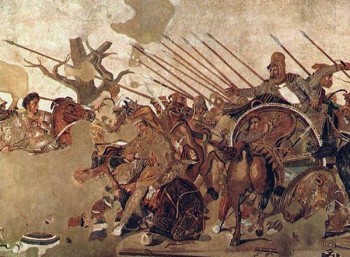In November 333 B.C. Alexander the Great confronts the Persian king Darius III Codomannus in the second major battle between their armies, following the earlier victory in the previous year at the battle of the Granicus and the decisive victory in the year 331 B.C. in the plains of Gaugamela. The battle of Issus actually took place at the Pinarus River on the south-eastern coast of the Mediterranean Sea. Alexander's army was greatly outnumbered. He commanded an army of 75,000 Greeks against an immense force of an acclaimed 600,000 soldiers, led by Darius.
Despite Darius' great qualities as organizer and commander, he had the bad luck to have as his opponent world history's most impressive commander and conqueror. It was the genius and the utter fearlessness of Alexander which shifted the balance completely to the Greek side. Leading the charge of his heavy cavalry and breaking through the Persian lines, he fought his way into the centre of the Persian army, towards Darius. A bloody fight erupted around the chariot of Darius and though Alexander got injured at his thigh it was Darius who could not hold the pressure. He fled from the battlefield.
The word about Darius' flee spreads out over the battlefield, and the Persian left and right wing collapse while the Macedonians push ruthlessly after having noticed Alexander forced a gap in the Persian formation. The victory is total. Darius managed to get away thanks to his fast chariot, but his mother, wife, and children are captured by Alexander. Sources name an estimated 110,000 Persian soldiers, 10,000 Greek mercenaries and 450 Macedonians being killed in the battle (10,000 to 20,000 casualties may be a more realistic, if still dreadful number).
The Battle of Issus has since become one of world history's main events, a major stage in the Alexander's rush towards conquest of the known world, establishing him as the greatest and most impressive conqueror of all time, opening a new stage in human history.
In November 333 B.C. Alexander the Great confronts the Persian king Darius III Codomannus in the second major battle between their armies, following the earlier victory in the previous year at the battle of the Granicus and the decisive victory in the year 331 B.C. in the plains of Gaugamela. The battle of Issus actually took place at the Pinarus River on the south-eastern coast of the Mediterranean Sea. Alexander's army was greatly outnumbered. He commanded an army of 75,000 Greeks against an immense force of an acclaimed 600,000 soldiers, led by Darius.
Despite Darius' great qualities as organizer and commander, he had the bad luck to have as his opponent world history's most impressive commander and conqueror. It was the genius and the utter fearlessness of Alexander which shifted the balance completely to the Greek side. Leading the charge of his heavy cavalry and breaking through the Persian lines, he fought his way into the centre of the Persian army, towards Darius. A bloody fight erupted around the chariot of Darius and though Alexander got injured at his thigh it was Darius who could not hold the pressure. He fled from the battlefield.
The word about Darius' flee spreads out over the battlefield, and the Persian left and right wing collapse while the Macedonians push ruthlessly after having noticed Alexander forced a gap in the Persian formation. The victory is total. Darius managed to get away thanks to his fast chariot, but his mother, wife, and children are captured by Alexander. Sources name an estimated 110,000 Persian soldiers, 10,000 Greek mercenaries and 450 Macedonians being killed in the battle (10,000 to 20,000 casualties may be a more realistic, if still dreadful number).
The Battle of Issus has since become one of world history's main events, a major stage in the Alexander's rush towards conquest of the known world, establishing him as the greatest and most impressive conqueror of all time, opening a new stage in human history.


